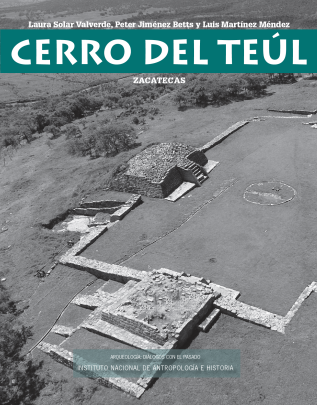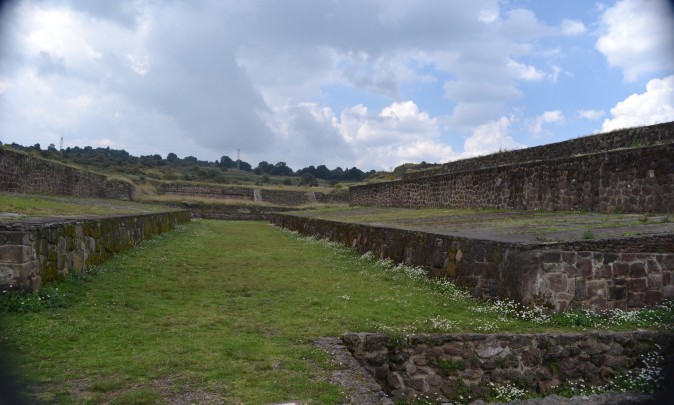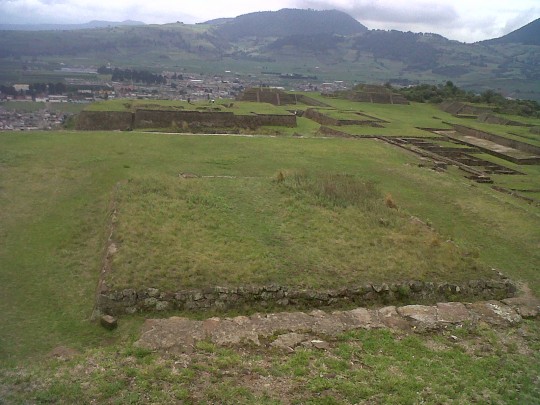Teotenango
The place of the divine wall
To the south of the Toluca Valley, this was successively a civic and religious center, a walled city and a military garrison (650-1550 AD). A jaguar is sculpted in bas-relief on a monolith in the impressive Plaza of the Jaguar. There are also other stone reliefs.
About the site
The pre-Hispanic settlement of Teotenago was built on the plateau of Cerro Tetepetl, mainly occupying the eastern part. To build the ancient city on a rocky prominence like this, it was necessary to modify the plateau with artificial infill and terraces, which formed part of a group of architectural structures organized around the plazas.
It is thought that the first groups who settled in the Valley of Toluca, as well as in the vicinity of Teotenago, had Otomi roots and were present on the lower slopes of the hill from 650 to 750 AD. The presence of people from Teotihuacan, who began as migrants to this area from the Valley of Matlatzinco, had an influence on the customs and daily life of the original inhabitants, as well as on the architecture, sculpture, pottery and arts generally.
Little is known about the first group of inhabitants who settled Teotenago. As they can be considered the founders of this city and religious center they have been given the name Teotenancas, and they exercised control of the city until 1200 AD, when it was invaded and conquered by a group of Chichimecs and Matlatzincas. Subsequently important defensive works were completed, remaining under Matlatzinca control until 1474. The final stage of occupation took place with the military expansion of the Aztecs.
The name of this settlement is attributed to the presence of a wall made from stone as part of the abovementioned defensive system. The glyph which represents the city has a half solar disk on the lower part, and above it there are precisely three sections of wall.
Although the existence of this archeological site was known through various historical sources and references by witnesses, it was not until 1971 that the Teotenago Project began under the direction of the archeologist Román Piña Chan. This project concluded in 1975 and after that date the interventions have been limited to minor maintenance works to the area open to the public.
It is thought that the first groups who settled in the Valley of Toluca, as well as in the vicinity of Teotenago, had Otomi roots and were present on the lower slopes of the hill from 650 to 750 AD. The presence of people from Teotihuacan, who began as migrants to this area from the Valley of Matlatzinco, had an influence on the customs and daily life of the original inhabitants, as well as on the architecture, sculpture, pottery and arts generally.
Little is known about the first group of inhabitants who settled Teotenago. As they can be considered the founders of this city and religious center they have been given the name Teotenancas, and they exercised control of the city until 1200 AD, when it was invaded and conquered by a group of Chichimecs and Matlatzincas. Subsequently important defensive works were completed, remaining under Matlatzinca control until 1474. The final stage of occupation took place with the military expansion of the Aztecs.
The name of this settlement is attributed to the presence of a wall made from stone as part of the abovementioned defensive system. The glyph which represents the city has a half solar disk on the lower part, and above it there are precisely three sections of wall.
Although the existence of this archeological site was known through various historical sources and references by witnesses, it was not until 1971 that the Teotenago Project began under the direction of the archeologist Román Piña Chan. This project concluded in 1975 and after that date the interventions have been limited to minor maintenance works to the area open to the public.
650- 1550
Posclásico Temprano a Posclásico Tardío
Posclásico Temprano
1474- 1550
Posclásico Tardío
Map
Did you know...
- The original name of this ancient city was modified by the Spanish. The syllable “teo” (god) in Teotenango was suppressed. Hence the municipal seat has come to be known today as Tenango del Valle.
- The Jaguar Monolith has been subject to various interpretations. According to the archeologist Román Piña Chan, “the sculpture commemorates the start of a new historical stage, that of the Teotencas who were related to the Fifth Sun.”
- With a length of 395 feet and a width of 130 feet, the Structure of the Serpent is the largest at Teotenango.
An expert point of view

María del Carmen Carbajal Correa
Centro INAH Estado de México
Practical information
Tuesday to Saturday from 09:00 to 17:00 hrs. Sunday from 10:00 to 14:30 hrs.
Se localiza en el cerro de Teotenango, al oeste del pueblo de Tenango de Arista, a 20 kilómetros al sur de Toluca, Estado de México.
From Mexico City, take the highway to Toluca as far Marquesa and then turn off for Tenango del Valle.
From the city of Toluca, take the Toluca-Tenancingo highway to Tenango del Valle. The entrance to the site is at the west end of the town.
From the city of Toluca, take the Toluca-Tenancingo highway to Tenango del Valle. The entrance to the site is at the west end of the town.
Services
-
+52 (722) 167 1325
-
This email address is being protected from spambots. You need JavaScript enabled to view it.
Directory
Responsable
Subdirección de Rescate y Conservación de la Secretaria de Cultura y Deporte del Gobierno del Estado de México
This email address is being protected from spambots. You need JavaScript enabled to view it.
+52 (722) 214 6300





















